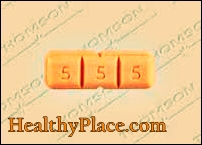Medication Treatments for ADHD - Busiprone (BuSpar) in Treating ADHD
 Busiprone (BuSpar) is a relatively new anti-anxiety medication which shows some promise in treating ADHD when psychostimulant medications are not effective or their side effects cannot be tolerated. It can also "potentiate" benefits of the serotonergic antidepressants. The side-effects of Busoprone are often better tolerated than those of other medications used for ADHD. It should always be remembered, that for reasons still not fully understood, every individual responds differently and uniquely to a specific medication. The effective administration of a specific medication for any psycho-neurological condition will still - and most likely will for quite some time - remain an art, rather than a science.
Busiprone (BuSpar) is a relatively new anti-anxiety medication which shows some promise in treating ADHD when psychostimulant medications are not effective or their side effects cannot be tolerated. It can also "potentiate" benefits of the serotonergic antidepressants. The side-effects of Busoprone are often better tolerated than those of other medications used for ADHD. It should always be remembered, that for reasons still not fully understood, every individual responds differently and uniquely to a specific medication. The effective administration of a specific medication for any psycho-neurological condition will still - and most likely will for quite some time - remain an art, rather than a science.
For adults with ADHD, it has been noted that women with ADHD often report especially severe PMS, and their spouses and children may be very troubled by their exceptional irritability and impatience during this time of the month. Medications such as BuSpar are often extremely effective in relieving PMS symptoms.
RELATED STUDIES:
Transdermal Patch Formulation of Anti-Anxiety Medication Holds Promise For Treating Hyperactive Children
C. Keith Conners, Ph.D.
Professor of Medical Psychology
Duke University Medical Center
Administration through a skin patch developed by Sano Corporation of a widely used anti-anxiety medication may provide a safe and effective treatment alternative for children with attention deficit hyperactivity disorder (ADHD), according to the results of a pilot study presented at a National Institute of Mental Health conference by Duke University researchers.
The drug buspirone (BuSpar) was administered to a group of 32 children with ADHD using a new transdermal (through the skin) delivery technology. The transdermal buspirone patch is not yet commercially available and will require completion of current trials as well as the necessary FDA review and approvals.
Following the eight-week, open-label study, 70-80% of patients treated were rated by parents and teachers as "much improved or very much improved," according to study-leader C. Keith Conners, Ph.D., Professor of Medical Psychology at Duke University Medical Center. "The treatment was well liked by parents and well tolerated by the patients in the study - important considerations in evaluating prospective therapies for ADHD," said Dr. Conners.
He noted that the results of transdermal buspirone evaluated in the phase II trial suggest that the therapy may offer several benefits for treatment of ADHD in children. Unlike oral medications that must be taken repeatedly at home and school, the transdermal patch is applied once each morning, relieving children and their caregivers of the daily responsibility and stigma of pill-taking.
Oral medications are frequently metabolized in the liver. In the drugs currently used to treat hyperactivity and attention deficit disorder this so-called "first-pass metabolism" releases active drug components erratically, creating fluctuations which increase the risk of inconsistent control of symptoms.
"The main difference is that oral drugs' side effects are associated with their peak level in thebloodstream, which is higher than their therapeutic level," Dr. Conners noted. "If you can reduce these peak levels, you can avoid a lot of adverse effects." He said that this may help account for the tolerability of the transdermal buspirone noted in the study.
The study looked at boys and girls aged 8-12 years who were physically healthy and had been diagnosed with ADHD. Two eight-child groups wore low- dose skin patches measuring either 2.5 cm2 or 5 cm2. Two high-dose groups of eight children began the treatment period with skin patches measuring 10 cm2 or 20 cm2. Patches were replaced daily. The high-dose skin patches were increased in size every 10 days.
According to Dr. Conners, the study demonstrated a relationship between dose and effect. That is, the two high-dose groups showed improvement in terms of clinical global impairment ratings by parents and teachers, while the low-dose groups showed less improvement. He characterized the side effect profile as mild and well tolerated.
The adverse effects reported were mild or moderate in severity and included insomnia (15.6%), reaction at the site of the patch (12.5%), headache (9.4%), and increased activity level (9.4%). There was one severe headache. The next steps in evaluating the therapy will be the analysis of placebo-controlled efficacy studies currently underway.
next: Medication Treatments for ADHD - Dextroamphetamine Saccharate / Dextroamphetamine Sulfate in Treating ADHD
~ adhd library articles
~ all add/adhd articles
APA Reference
Staff, H.
(2003, December 1). Medication Treatments for ADHD - Busiprone (BuSpar) in Treating ADHD, HealthyPlace. Retrieved
on 2025, November 29 from https://www.healthyplace.com/adhd/articles/medication-treatments-for-adhd-busiprone-buspar-in-treating-adhd

